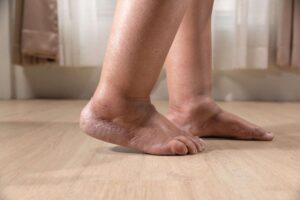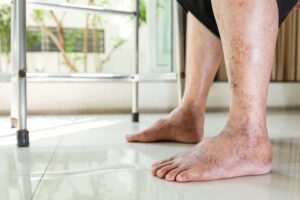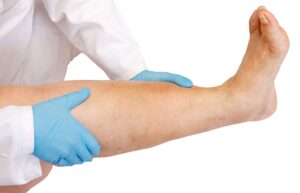Leg edema, also known as leg swelling, is a condition characterized by too much fluid in the lower extremities. While it can affect individuals of all ages, it commonly affects older adults and people who are pregnant. Understanding the causes, treatment options, and the impact of leg edema on wound care is crucial for healthcare providers and individuals dealing with this condition.
Leg Edema: What is it?
 Leg edema refers to the abnormal accumulation of fluid in the legs, leading to swelling, discomfort, and heaviness. It primarily affects the lower extremities, such as the feet, ankles, and calves. Various types of leg edema exist, including pitting edema, non-pitting edema, lymphedema, and edema related to venous insufficiency. Some of the common symptoms often associated with leg edema can include:
Leg edema refers to the abnormal accumulation of fluid in the legs, leading to swelling, discomfort, and heaviness. It primarily affects the lower extremities, such as the feet, ankles, and calves. Various types of leg edema exist, including pitting edema, non-pitting edema, lymphedema, and edema related to venous insufficiency. Some of the common symptoms often associated with leg edema can include:
- Swelling in the legs, ankles, and feet
- Puffiness or heaviness in the affected areas
- Discomfort or pain in the swollen areas
- Restricted range of motion due to swelling
- Visible changes in skin texture, such as tightness or shiny appearance
- Skin discoloration or redness
- Visible veins or varicose veins
- Difficulty fitting into shoes or socks
- Reduced ability to walk or perform daily activities due to leg swelling
- Worsening symptoms after prolonged periods of sitting or standing
Causes of Leg Edema
Several underlying conditions can put you at added risk of developing leg edema including:
- Venous Insufficiency: When the veins in the legs fail to adequately pump blood back to the heart, it can result in fluid retention and leg edema. Varicose veins and deep vein thrombosis (DVT) are common contributing factors.
- Lymphatic Obstruction: Damage or blockage in the lymphatic system can impair fluid drainage, leading to leg edema. Lymphedema, often resulting from cancer treatment or infection, is a primary example.
- Heart Failure: In cases of congestive heart failure, the heart struggles to pump blood effectively, leading to fluid accumulation in the legs, ankles, and feet.
- Kidney Disease: Impaired kidney function can result in fluid retention and leg edema due to the body’s inability to remove excess fluids and waste.
- Medications: Certain medications, such as calcium channel blockers, nonsteroidal anti-inflammatory drugs (NSAIDs), and corticosteroids, can cause leg edema as a side effect.
- Pregnancy: Hormonal changes and increased pressure on the veins during pregnancy can often lead to leg edema. However, the condition usually resolves after childbirth.
- Obesity: Excessive weight can put additional strain on the legs, leading to leg edema.
- Inflammatory Conditions: Conditions such as arthritis and cellulitis can cause inflammation in the legs, contributing to fluid retention and edema.
- Other factors such as sitting or standing in one position for too long or diets in high in salt can also put you at added risk of developing edema.
Leg Edema After Surgery
 Postoperative edema is a common occurrence after surgery, as it can disrupt the body’s fluid balance. Proper wound care, compression stockings, elevation, and prescribed medications are typically recommended to help reduce edema after surgery. It is important to follow the post-surgical care instructions provided by your wound care specialist to manage and alleviate postoperative leg edema effectively.
Postoperative edema is a common occurrence after surgery, as it can disrupt the body’s fluid balance. Proper wound care, compression stockings, elevation, and prescribed medications are typically recommended to help reduce edema after surgery. It is important to follow the post-surgical care instructions provided by your wound care specialist to manage and alleviate postoperative leg edema effectively.
Is Leg Edema Dangerous?
While leg edema itself is generally not life-threatening, if left untreated it can lead to serious complications. Prolonged edema can increase the risk of infections, deep vein thrombosis, and skin breakdown. Seeking timely medical attention and adhering to recommended treatment plans are crucial to prevent potentially life-threatening complications.
Impact of Leg Edema on Wound Care and Healing
Leg edema can have a significant impact on wound healing and the overall care of wounds. Here are some ways in which leg edema affects wound care:
- Impaired Circulation: Edema restricts blood flow, impairing the delivery of oxygen and nutrients to the wound site, which is an essential component of healing.
- Delayed Wound Healing: Insufficient blood flow and reduced oxygen supply can delay the wound healing process, prolonging recovery time.
- Increased Risk of Infection: Edematous tissue is more prone to bacterial and fungal infections due to compromised immune response and the presence of excess moisture.
- Challenges in Wound Dressings: Swollen legs can make it challenging to apply wound dressings properly, resulting in poor wound coverage or inadequate compression.
Treating Leg Edema
 While treatment for leg edema can vary depending on your situation, the approach typically involves addressing the underlying cause and managing the symptoms. Although as mentioned above, it’s always recommended to consult a wound care specialist for recommendations based on your individual circumstances, here are a few of the more common treatment approaches typically utilized:
While treatment for leg edema can vary depending on your situation, the approach typically involves addressing the underlying cause and managing the symptoms. Although as mentioned above, it’s always recommended to consult a wound care specialist for recommendations based on your individual circumstances, here are a few of the more common treatment approaches typically utilized:
- Lifestyle Changes: Elevating the legs, regular exercise to improve circulation, weight management, dietary changes, and quitting smoking can all help contribute to reducing leg edema.
- Compression Therapy: Compression stockings, wraps, or compression devices can help reduce swelling and improve blood flow.
- Medications: Diuretics may be prescribed to promote fluid excretion. Anticoagulants may be recommended for individuals with underlying blood clot issues. Lymphatic system stimulants can also aid in lymphatic flow.
- Surgical Interventions: In severe cases, surgical procedures may be considered as well.
Wound Care Considerations for Leg Edema
When managing wounds in individuals with leg edema, a wound care specialist will take the below approaches and considerations:
- Assessing the Wound: Evaluating the wound’s size, depth, and overall condition to help determine the appropriate treatment plan.
- Ensuring Adequate Circulation: Addressing leg edema through compression therapy and lifestyle modifications can help improve blood flow to the wound area.
- Choosing the Right Wound Dressing: Choosing dressings that manage moisture, promote healing, and provide appropriate compression is crucial for effective wound care.
- Preventing and Treating Infections: Regular wound cleansing, applying appropriate antimicrobial dressings, and promptly treating infections are vital to avoid complications.
- Regular Monitoring and Follow-Up Appointments: Regularly monitoring the wound’s progress, adjusting treatment plans as necessary, and following up with a wound specialist are crucial for successful wound healing.
Can Leg Edema Be Prevented?
While in some cases edema might not always be preventable, there are adopting preventive measures that can help minimize the risk. These can include maintaining a healthy weight, engaging in regular physical activity, avoiding prolonged sitting or standing, wearing compression stockings, practicing proper leg hygiene, and staying hydrated. Additionally, managing underlying conditions such as heart disease or kidney problems can contribute to preventing leg edema.
Conclusion
Leg edema can significantly impact one’s quality of life, but understanding its causes, seeking appropriate treatment, and implementing preventive measures can provide relief and improve overall well-being. If you experience persistent leg edema or have concerns, the specialized team at West Coast Wound Center can help develop a personalized treatment plan and put you on the path to healing and recovery. Book an appointment today.
